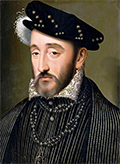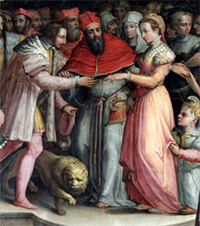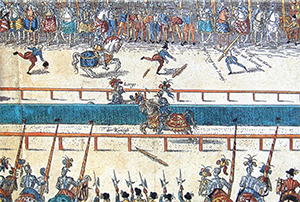The French King Henry II
Henry II was King of France during the 16th Century. He was known for his external wars and his internal religious persecutions. His queen was the famous Catherine de Medici. 
He was born on March 31, 1519, at Saint-ermain-en-Laye, near Paris. His father was the reigning monarch, King Francis I. When Henry was just 7, he and his older brother, Francis, went to Spain as a hostage as part of the terms of the Peace of Cambrai, the latest in a series of truces agreed between King Francis I and Charles V, the Holy Roman Emperor and King of Spain. The boys returned home in 1530. 
Henry married Catherine de Medici in 1533; both he and she were 14. Three years later, the Dauphin died, and Henry became the heir to the throne. When the king died, in March 31, 1547, Henry became king. The new monarch embarked on a handful of reforms but also continued his father's quest to defeat Charles V. After securing an alliance with a group of powerful German princes, he went to war with Spain. Henry had the same kind of luck against Charles V that Francis had initially, signing a peace agreement with Charles in 1556. Henry also fought against Austria, defeating the Habsburg force at Renty in 1554 and solidifying an occupation of the Loire and the capture of the bishoprics at Metz, Toul, and Verdun. In that same year, however, Henry found himself defeated, at the Battle of Marciano. Two years later, a French king finally got the better of Charles V but only on a technicality. The Spanish King and Holy Roman Emperor had had enough fighting and, after the Peace of Augsburg (which was more about religious preference than about territorial gains), began abdicating as ruler of his various domains. He handed over the throne of the Holy Roman Empire to his brother Ferdinand and the throne of Spain to his son Philip. Henry had invaded Tuscany but had been repulsed. England entered the conflict in 1557, after Henry had shifted to fighting in Flanders, and Henry, after losing Calais and seeing the writing on the wall, agreed to the Peace of Cateau-Cambrésis, which included the promise of Henry to marry his daughter Elizabeth to Philip II of Spain and his sister Margaret to Emmanuel Philibert of Savoy. He had his son Francis, who suffered from ill health and physical disability, married to Mary, Queen of Scots, in 1558. All involved hoped for a son who could be King of France and King of Scotland. The treaty that Henry signed with German princes was with Protestants. At the same time, Henry was a devout Catholic and targeted Protestants in his own country. Just after his ascension, he installed the Chambre Ardente in the Parlement of Paris, in order to try heretics. In the last year of his reign, he issued the Edict of Écouen, to further religious prosecution. He particularly targeted the Huguenots, with the 1551 Edict of Châteaubriant, which included a ban on unapproved books. 
Henry was quite fond of jousting and liked to participate in tournaments. He did so at one such competition in June 1559. The gathering was to mark a peace treaty with Spain, and the tournament lasted several days. The king complained of discomfort before the tournament even started, and his wife urged him not to compete. Yet he did and was successful. He struggled against Gabriel, the Count of Montgomery and captain of the Scottish Guard, who nearly forced the king off his horse. The stubborn king insisted on a rematch, and the reluctant count finally agreed. In the ensuing clash, Montgomery was just accurate enough with his lance to connect with the king's helmet, and a splinter struck his eye and went straight into his brain. The royal doctors who removed the king's helmet found other splinters, in his head and throat, and removed them all. Henry never recovered, dying on July 10. He was 40. Henry and Catherine had had 10 children together, of whom three became king, in succession: Francis, Charles, Henry. Taking the throne at just 15 years of age was the oldest son, who became King Francis II. One other thing Henry II was known for was in the realm of invention. He required an inventor to describe the invention in writing, in the form of a patent specification; if the king approved, then he would grant monopoly rights for that invention to the inventor who submitted the specification. The first of these went to Abel Foullon, Henry's director of the Mint and the royal engineer after Leonardo. Foullon invented the Holometer, a type of rangefinder used in surveying. |
|
Social Studies for Kids
copyright 2002–2025
David White




